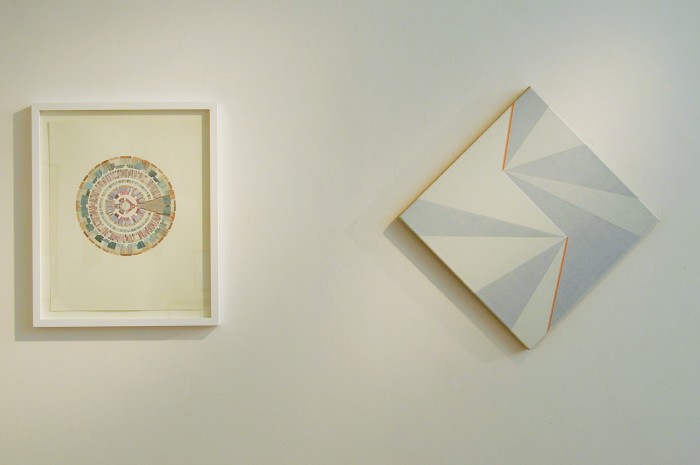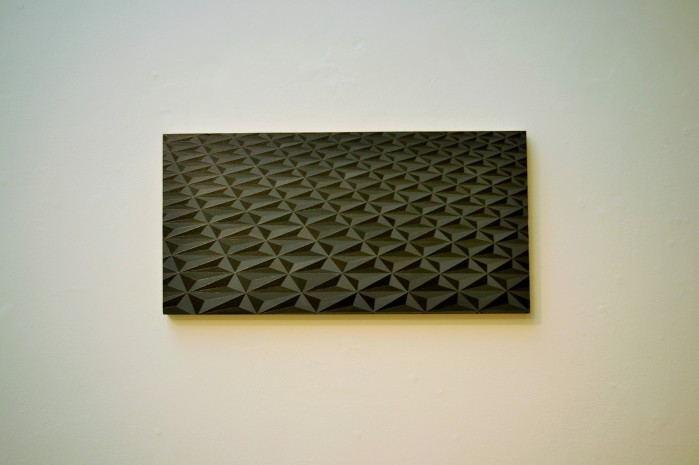Archive for the ‘Abstract art’ Category
Generator Discussion
On the final day of the Generator exhibition, Duncan Brennan from Kaleidoscope Gallery, posed a few questions for discussion by the artists. Here is an attempt at recovering some of the conversation from notes. I wasn’t actually there. Think of it as an exercise in constructed memory. I have also taken the liberty of adding some thoughts of my own. I think that the questions alone are generative enough to be worth a post.
DB: How would you define the type of work in this exhibition?
HH: It is work that is created by using a mathematical or logical system
CP (from the exhibition introduction): artwork that is by nature ‘generative’, created once an artist cedes control to an external system or set of rules. The artwork thus results not from the wholly instinctive decisions of the artist, but is formed by objective rules or logical instructions that shape its process or material outcome.
DB: Can you talk about some of the defining characteristics of generative work?
AP: In his 2010 paper Program, be Programmed or Fade Away: Computers and the Death of Constructivist Art, Richard Wright summarises Kenneth Martin’s division of systematic work into three types : 1) the completely predefined system which once set in motion can generate work independently of any further input from the artist. 2) a system that may be initially predefined but is then constantly altered through feedback, bringing into contact with other systems, the ‘program’ thereby being written in conjunction with the work itself. 3) the system which builds up from a primary act without any previous planning, like a self propelled aggregation of logical steps. The works in Generator may be closest to the first of these three definitions.
DB: What makes this different to other forms of abstraction, such as constructivism?
AP: I think it is situated within the Constructivist tradition, though that historical moment has passed. British Constructionist and Systems Group artists saw the need to abandon its utopianism and showed how art could be generated by a numerical or mathematical system. It is different from expressionism, which has been another strand within abstraction.
HH: Constructivism was /is a more political form of creation. Generative art has its own roots, the methodology and interpretatons are unique to the individual
DB: Would you agree that rules need to be constructive rather than restrictive?
HH: Everything in the world is generated by rules. Painting a landscape has rules that govern the outcome of what will be a recognisable presentation. Working in the constraints of rules or systems allows the artist to interpret data and input in many ways. I use a system at work which plots the movement of the railways in graphic representation. I use the variations in the programme to generate some of my own work, the patterns vary according to the input in spite of the fact that the system itself is governed or regulated by a computer.

Left Christina France, Equilibrium 1 and 2, pigment, archival digital print on German etching paper, 80 x 60 cm. Right Hanz Hancock, Untitled, 2015, mixed media, 51 x 51 cm
DB Can a computer make art?
HH: A computer can make extremely complex patterns/can create algorithmic sequences , it cannot make emotional decisions as to what looks good. That is down to human preference. I/we make sequences based on numerical systems, something working within the grid. Patrick created several works that generated themselves: a module was sent into rotation within a grid, in a concentric spiral and each module had a graphic relationship or difference to the positioning of the the other. However, because of the repetitive nature of the system, repeating aggregations became apparent, appearing almost at random within the matrix, i.e. the formation of pattern. This could then be sampled and magnified into groups and in turn, work was made from tha , a sort of generative mechanism or device to generate pattern.
JI: Yes, computers can make art but humans make computers. The computer is just a tool. An algorithm, performed by a computer, is just a mirror of a set of processes condensed in time and space. It is in this compression that the art lies.
AP: Your question reminds me of a story told by that great systems thinker Gregory Bateson, of a computer programmer in the days of big mainframe computing, who wanted to know about mind in his private large computer. He asked it, “Do you compute that you will ever think like a human being?” The machine then set to work to analyse its own computational habits. Finally, the machine printed the answer ticker tape style, as such machines used to do. The programmer ran to get the answer and found, neatly typed, the words: THAT REMINDS ME OF A STORY”.

James Irwin, Silicon Binary Progression (ii), 2014, HD video, monitor, media player, dexuob speed frame, MDF, 4 mins 15 secs
DB: Has the computer changed the focus of generative art? Is the computer to generative art what the camera was to representational art?
JI: Good question and there’s probably the same analogue relationship between the computer and generative work, and the camera’s photographic image. It’s not that simple though. Using the computer is just one way of working generatively. It isn’t definitive of generative art.
HH: Human beings create programs by which the computer will create images, but the camera can only record the image which can then be manipulated both outside of the camera and electronically inside. The human brain has always generated images and pattern forming/art. The computers is a tool not a focus, as is the camera for human imagination.
AP: I have my doubts about that little word “just”, as much as I do also about the idea of the computer as a tool. It seems to me that the computer, and indeed technology more generally, gets characterised as just a tool to make it seem smaller than us and in our control, like a spanner, a hammer or a paint brush, when in fact, as a system it obeys its own rules, and incorporates us into its usage. Nevertheless, in Generator it is the contemporary analogue, rather than digital, ‘programmatic’ that is being explored. The computer programme is often used as a metaphor for the human processes of thinking/doing, so we might wonder what the programme is for activities like walking, or breathing, or even attempt to codify neuro-linguistic programmes for performance excellence in any particularly field. In this exhibition the systems that generates the artwork are thought of as analogue programmes, which have clearly been around a lot longer than have computer programmes, but only now that we have the computer are we able to utilise the metaphor for thinking about thinking. I like the circularity of it.

Left, Mary Yacoob, Modular Hakka House, 2014, ink and graphite on paper, 50.8 x 40.6 cm, Right, Katrina Blannin, blackgreyblackgreyblackwhiteblackwhiteblackwhite-orange 50, 2015, acrylic on linen, 70 x 70 cm
DB: What characterises good generative art? Is it necessary to be either or both conceptually and aesthetically strong?
AP: I think Natalie Dower and Jeffrey Steele answer this best. Here’s Dower in an interview with Patrick Morrissey: “If the input that has generated the idea does not translate into valid visual terms I do not accept it. I have had intellectually interesting ideas that I have had to abandon for that reason”. And here’s Steele in an interview with Katrina Blannin: “…something has good Gestalt or bad Gestalt — has it got a clear shape to it? I can look at one of my paintings and see whether it has good Gestalt or bad, and this has happened occasionally. A clear process of abstract thinking should lead to a satisfying visual Gestalt. I don’t necessarily “reject” or stop working on a project when this is not happening, but it bothers me, and I want to know what is going wrong”.
DB: Are you looking to formalise the human aesthetic?
JI: A human aesthetic is wide reaching and all encompassing. Defining a human aesthetic as work that shows signs of ‘the hand’if that’s what the question suggests, is too limiting”
AP: Maybe formal logic and formal linguistics, abstract languages, like mathematics, all pertinent to computer programming, have close connections to the formal ‘language’ of abstract painting.
DB: Does any of your work explore any of the hypotheses, the rules and processes of the scientist? Do you think generative art work like this can inform scientific study?
AP: I was going to say that whilst likely to have been informed by scientific study, the relationship is unlikely to be reciprocal, but then I remembered that some of the truly fascinating discoveries made in the last few decades in the science of visual cognition was discovered by map makers in the seventeenth century, so I guess you never know!
Moira Dryer
Terry Greene recently drew my attention to an open letter from David Rhodes to Philip Guston. Then I saw this other letter from Rhodes to an artist whose work I have been getting to know recently: Moira Dryer. His letter at brooklynrail.org tells of a visit to Carol Szymanski and Barry Schwabsky in New York, seeing a small gouache by Dryer (photo) and being impressed by it. He comments on her approach to painting, about her influence on abstraction and regrets her passing (she died in 1992, when she was only 34 years old). He seems to agree with a comment I found by Bob Nickas that “she managed to make abstraction feel vital again” at a time when it no longer seemed as urgent or vibrant as it once did.
Here’s a picture I took of her wonderful painting entitled The Vanishing Self Portrait. I have written about it before, when I compared it to two other “abstract portraits”.
I wondered if there were any of her paintings in UK collections, and so far I haven’t been able to find any (please let me know in ‘comments’ if you come across one). Instead I found this video at Rough Cuts of a painting show at Harris Lieberman N.Y. where we get to see one of Dryer’s paintings (at 2.50 and between 6.38 and 7.07 mins). In his commentary, James Kalm doesn’t tell us if it has a title. He does bring our attention to the handles attached to the sides and says that’s common for Dryer. Like the tree stump in the one above, they emphasise the support. With the tree stump I feel reminded of the connection to nature, there’s no getting away from it even in abstraction. With the handles, it is more the process of painting Vs utility that I connect to: was the stretcher held by the handles and tilted to control the flow of wet paint? I doubt it, but I like that the artwork gets me guessing about that.
For Dryer, painting is theatre, performance, and in both these paintings it seems appropriate to be thinking about how they were made. In The Vanishing Self Portrait the brush strokes, (or possibly erasure strokes) look gestural, I imagine the artist extending her arm from one end of the canvas to the other. Then I realise that it’s probably too wide to have been made that way. But here I am, considering the making of it and speculating about the details of that performance, whilst clearly seeing its results directly in front of me.








